Tomato Leaf Problems: A Visual Guide
As an Amazon Associate and member of other affiliate programs, I earn from qualifying purchases.
If you’ve ever grown tomatoes before, you’re probably familiar with tomato leaf problems. You might have noticed your tomato plant leaves turning yellow, brown, or getting spots.
So what causes these tomato plant problems?
We all love the flavor of a homegrown tomato. You just can’t get the same intensity and sweetness from any tomato at the grocery store. But homegrown tomatoes also come with lots of pest and disease issues.
The unfortunate reality is that tomatoes are susceptible to many pests and diseases. And many of them lead to yellow or brown spots on tomato leaves. Often you can determine the cause of the issue just by looking at the leaves.
The particular pattern of yellowing or spotting will give you lots of information about what disease or pest is plaguing your tomato plant. Use this guide to tomato leaf problems to help you figure out what’s wrong and what, if anything, you can do about it.
Having troubles with your tomato fruit? Read this guide to tomato fruit problems.
If you’re a book person, you’ll love these resources for growing tomatoes that I keep in my garden library.
There’s a lot of information in this article.
Feel free to read about all of them, but if it seems overwhelming, scan through the bolded words for the particular symptom you’ve noticed on your tomato plant and read just that section. And all the way at the bottom, I have some quick tips for dealing with tomato leaf problems.
Also, make sure you pin this article for later so you can refer back to it whenever you see tomato leaf issues come up.
Nutrient deficiencies that cause pale or yellow leaves on tomato plants
Whenever your plant’s leaves look pale, but the plant is otherwise healthy, try adding an organic liquid fertilizer first. Neptune’s Harvest is a reliable brand that we frequently use. Liquid fertilizer is more quickly absorbed, and you should notice improvement within a day or two.
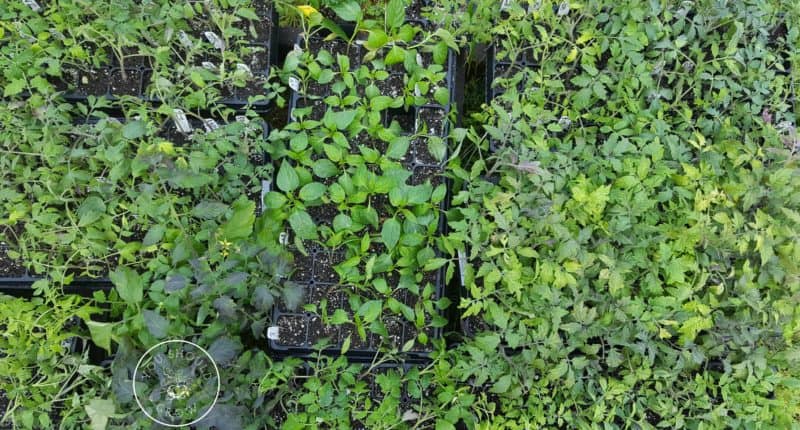
Whatever the deficiency, the liquid fertilizer should take care of it. But if you want to know exactly which nutrient is deficient, you might be able to figure it out by looking at the specific pattern of yellowing.
If you notice your young leaves (those at the top of the plant) are yellow with green veins, suspect iron deficiency. Check your soil pH to make sure it is between 6 and 6.8. If it’s too high, your tomato can’t take up necessary nutrients including iron.
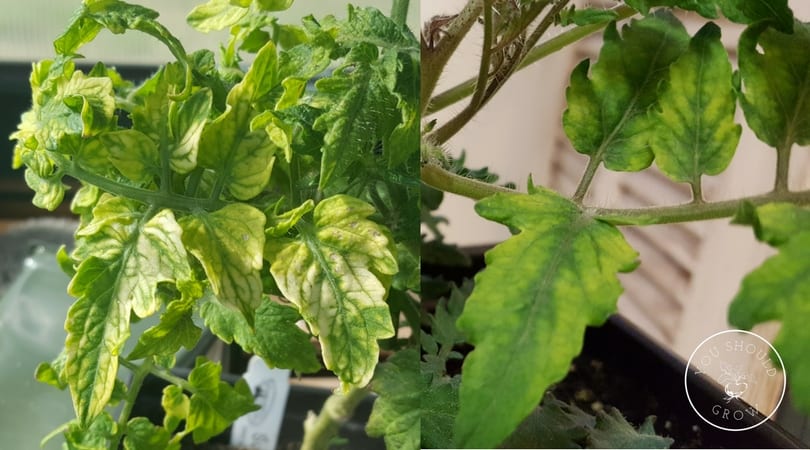
If you notice older leaves (those at the bottom of the plant) are yellow with green veins, suspect potassium deficiency.
If you notice dark spots within the yellow areas and the leaves are small and narrow, you might have a zinc deficiency.
If young leaves are pale and the growing tips of your tomato plant die, suspect calcium deficiency.
Stunted plants with general yellowing of the leaves is an indication of nitrogen deficiency.
It’s best practice to have your soil tested to confirm nutrient deficiencies before adding anything other than organic fertilizer and compost.
Adding too much synthetic fertilizer can burn your plants, and overuse of lime and wood ash can alter your soil pH causing more problems with nutrients than they prevent.
Learn about using fertilizer in your veggie garden.
Yellow tomato leaves due to pests
Pests are a common cause of tomato leaf problems. They are often carriers of tomato diseases as well, so it’s prudent to keep an eye out for any insects on your tomatoes. Read about some of the bugs I’ve found in my tomatoes.
Aphids love tomato plants and cause yellow, misshapen, and sticky leaves. Look for tiny insects on the undersides of leaves and on the stem. These pests will suck the sap from your tomato plant and can be a real problem in any garden.

They can be many colors, but we often see the red/pink ones. Ants love the sticky substance they excrete, and you may have an issue with both insects at the same time.
There are several options for organic aphid control including neem oil and diatomaceous earth.
Brownish, finely dotted leaves with thin webs are an indication of spider mites. Look for tiny spider-like insects on your leaves that make fine webs between and below the leaves. Infested leaves will dry up and fall off.
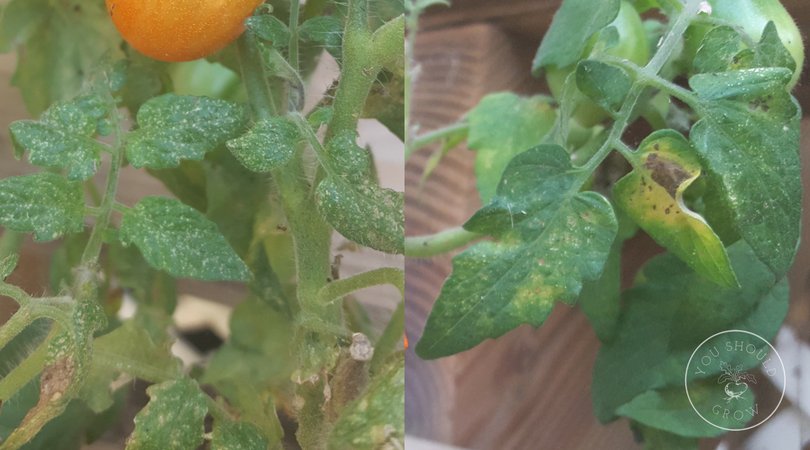
Spider mites and aphids can be treated with diatomaceous earth (DE). DE is a natural substance that is readily available at local garden centers.
We use a plant duster like this one to apply diatomaceous earth to affected plants. This powder will cut through the aphids’ soft exoskeletons and cause them to dehydrate and die.
Rain and watering will negate the effect of the DE so reapply as needed. Be careful to use DE in well-ventilated areas as inhaling this powder can cause damage to your lungs. And the lungs of kids, pets, and chickens, too!
If they get really bad, other forms of organic pest control including insecticidal soaps and spinosad sprays can also help.
Yellow leaves with holes
Whenever you see holes in your tomato leaves, you should suspect insect damage. Colorado potato beetles, tomato hornworms, grasshoppers, and flea beetles are all common culprits. Remove and squish these pests when you see them and utilize organic pest control practices to manage them.
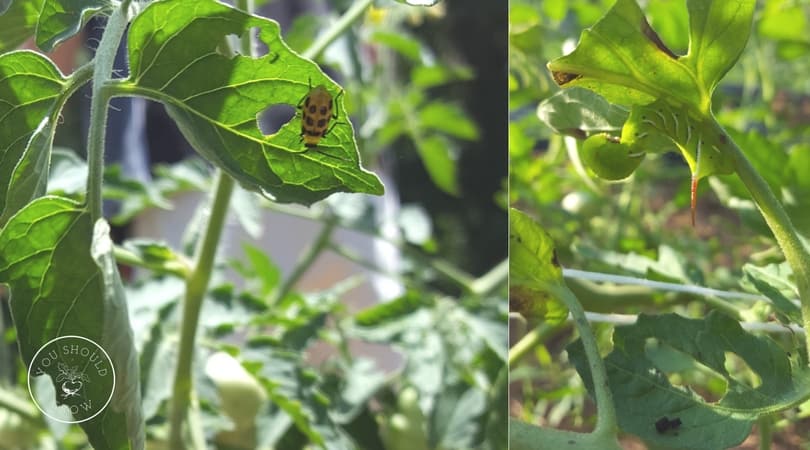
Yellow leaves and plants that wilt
There are several kinds of wilt caused by bacteria, fungi, nematodes, and toxins that can affect tomatoes. Regardless of the cause of the wilt, it’s best to remove severely affected plants from your garden and destroy them.
For mild infections, remove affected leaves (usually the lower leaves) and send them to the landfill or burn them in an area well removed from your garden. Do not compost diseased plants or leaves.
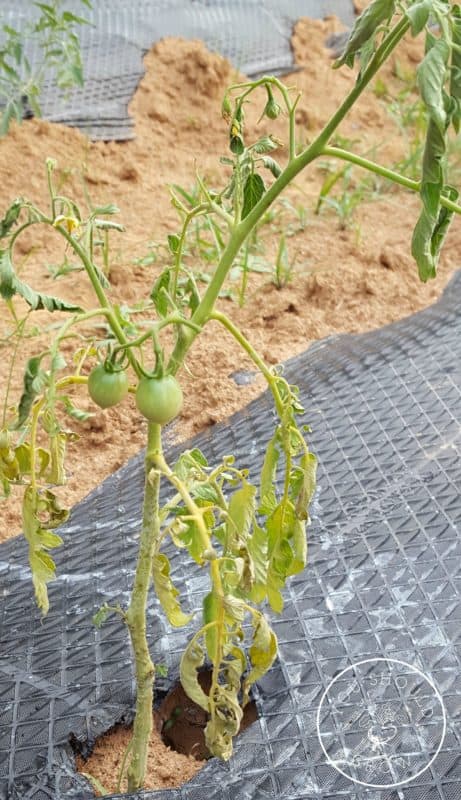
Fusarium and Verticillium wilt cause yellowing and wilting beginning with the lower leaves.
Tomatoes planted within about 50 feet of a black walnut tree, may suddenly wilt and die. This is caused a toxin secreted from the roots of black walnut trees and tree stumps.
Nematodes in the soil can infect the roots of your plants and cause wilt. If you pull up wilted plants and notice swollen sections in the root balls, nematodes may be the problem. Choose resistant varieties and/or add parasitic nematodes to decrease the incidence of disease.
There are many varieties of tomatoes that are documented to be resistant to various types of wilt. Look for resistance codes BFNV (Bacterial, Fusarium, Nematodes, Verticillium).
A note about resistance: don’t expect resistant varieties not to be affected by these diseases. Expect them to tolerate the disease. Remove and destroy affected leaves as they appear, and the plant should continue to produce fruit for you.
Yellow leaves with brown spots, mottled, or dappled appearance
Pale thin spots like the ones below are due to leaf burn. Leaves will experience sunburn when they haven’t been properly hardened off or when water droplets concentrate light on the leaves. If the burn is not too extensive, your plants will heal on their own and are not cause for concern.
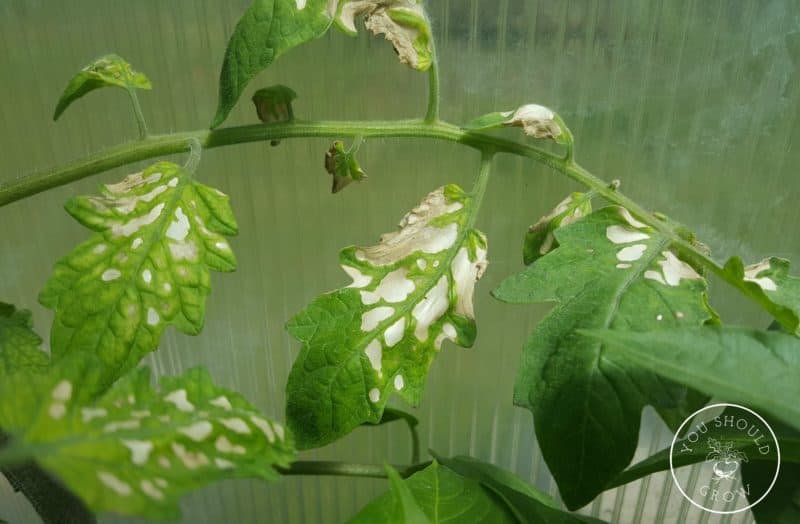
Leaf problems due to tomato plant diseases
Tobacco Mosaic Virus
Dappled yellow leaves with twisty new growth are common with tobacco mosaic virus. This virus is often transmitted by insects and especially aphids.
Do not try to treat these plants. Destroy them and remove them from your property, and be sure to wash your hands after touching any plant you suspect could be infected with this virus.
When choosing tomato varieties for future gardening seasons, look for the TMV resistant label.
Bacterial Speck and Bacterial Leaf Spot
Small dark spots on leaves that then turn brown and fall off are a symptom of bacterial speck and bacterial leaf spot. These diseases thrive in hot, humid environments and can be transmitted by your hands and garden tools.
Be careful working with plants suspected to be infected with this disease. To prevent future issues, remove and destroy severely infected plants and choose varieties with BLS and PST resistance in the future.
Late Blight on tomatoes
Leaves develop brown patches that turn dry and papery when tomato plants become infected with late blight. Sometimes a white mold grows along the edges of the brown patches. If your tomato plants have late blight you will also notice blackened areas along the stems and the tomatoes develop hard brown lesions.
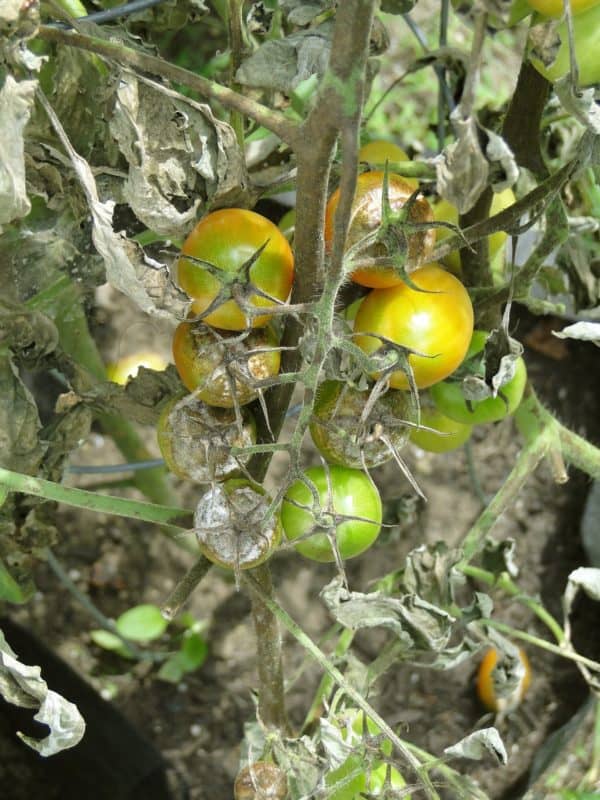
Late blight will wipe out your tomato crop, and there is no treatment for infected plants. So try to prevent this disease by removing and destroying infected plants. Don’t compost them. Send them to the landfill and clean and remove all remnants of the infected crops from your garden.
Here’s a video from the University of Maine about late blight:
For future crops, try applying a preventative copper fungicide or Bacillus subtilis spray, make sure to water your plants at the base as wet conditions favor the spread of this disease, and look for resistant varieties labeled LB.
Septoria Leaf Spot
Septoria leaf spot has a similar appearance, but the brown patches are circular with light centers and dark specks. And the disease will start with the older leaves. Trim off infected leaves and remove them from your garden. Sanitize your hands after dealing with infected plants.
Early Blight on tomato plants
Early blight causes spots of dark concentric rings on leaves and stem of the lower plant first.
Early blight tends to strike your tomato plants when they’re loaded with fruit and days are humid and warm.
Preventative sprays may help slow the onset and spread of the disease, but infected plants should be removed and destroyed. Look for resistant varieties labeled AB (A for Alternaria fungal species) for future gardens.
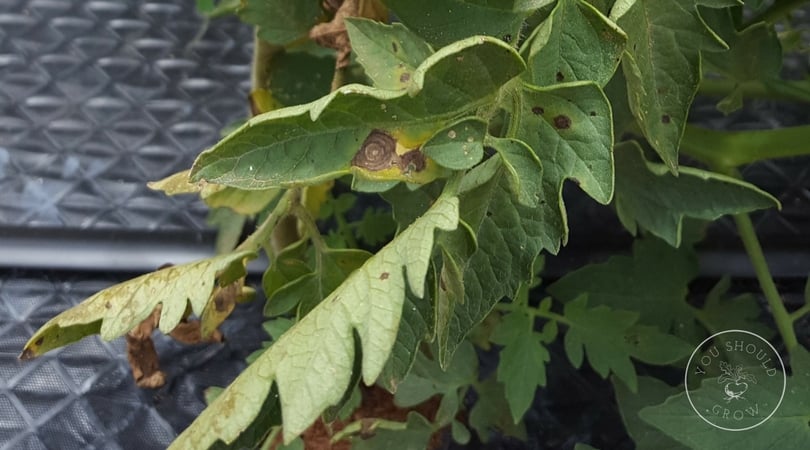
Tomato Spotted Wilt Virus
Dark brown rings on the leaves can also be caused by tomato spotted wilt virus. In this disease process, you’ll also notice brown streaks on the stems, stunted or one-sided growth, and green rings on immature fruit.
This disease is spread by tiny flying insects called thrips. Check purchase plants carefully for signs of thrips and disease before bringing them home to your garden.
Practice good pest control and remove infected plants to control the spread of this disease. Resistant varieties are labeled TSWV.
Bacterial Canker disease on tomato plant leaves
Leaves with brown edges may be caused by bacterial canker. Lower leaves will also curl up and you may see light brown streaks on the stems of your plant. This disease often shows up after plants have been injured, so be careful when trimming your plants not to leave open wounds.
A note about disease resistance:
Don’t expect resistant varieties not to be affected by these diseases. Expect them to tolerate the disease. Remove and destroy affected leaves as they appear, and the plant should continue to produce fruit for you.
Tomato leaf problems you should not worry about
Tomato leaf curl is often an environmental change due to stress. With no other symptoms of disease, no treatment is necessary.
Purple leaves are caused by the expression of anthocyanin due to light exposure. Often appearing on plants grown under intense light, there is no cause for concern or need for treatment of purple tomato leaves.
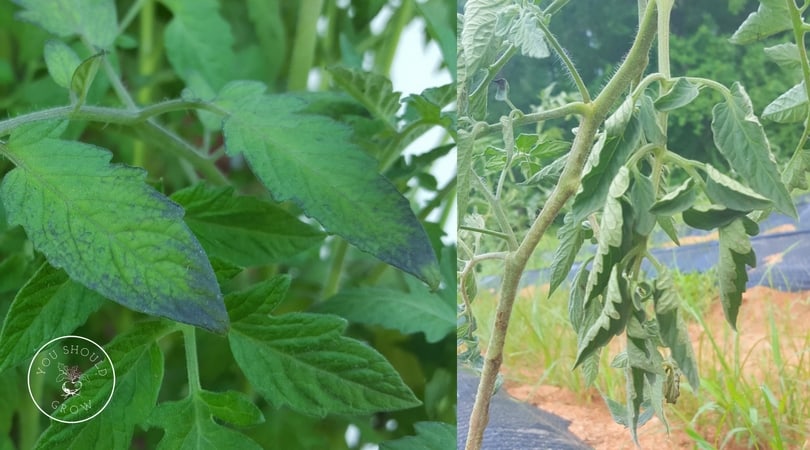
Phew! Did you make it through all of that?
Thanks for sticking around this long! There’s too much information to commit it all to memory, so here’s the take-home message.
Quick tips for dealing with tomato leaf problems.
- Make sure your plants have adequate nutrients. Try an organic liquid fertilizer first.
- Check for pests on the stems and undersides of your tomato leaves. Remove them by hand and use organic pest control sprays retreating as needed.
- If you do find leaves that are yellow, wilted, or spotty. Remove them immediately and dispose of them in your trash. Wash your hands after you handle any plants you suspect may be infected with fungal, bacterial, or viral diseases.
- Plant resistant varieties remembering that even resistant plants can be affected by tomato plant diseases but will often continue to produce if cared for properly (remove infected leaves, water, fertilize).
- Severely affected plants should be removed from the garden and disposed of as soon as possible.


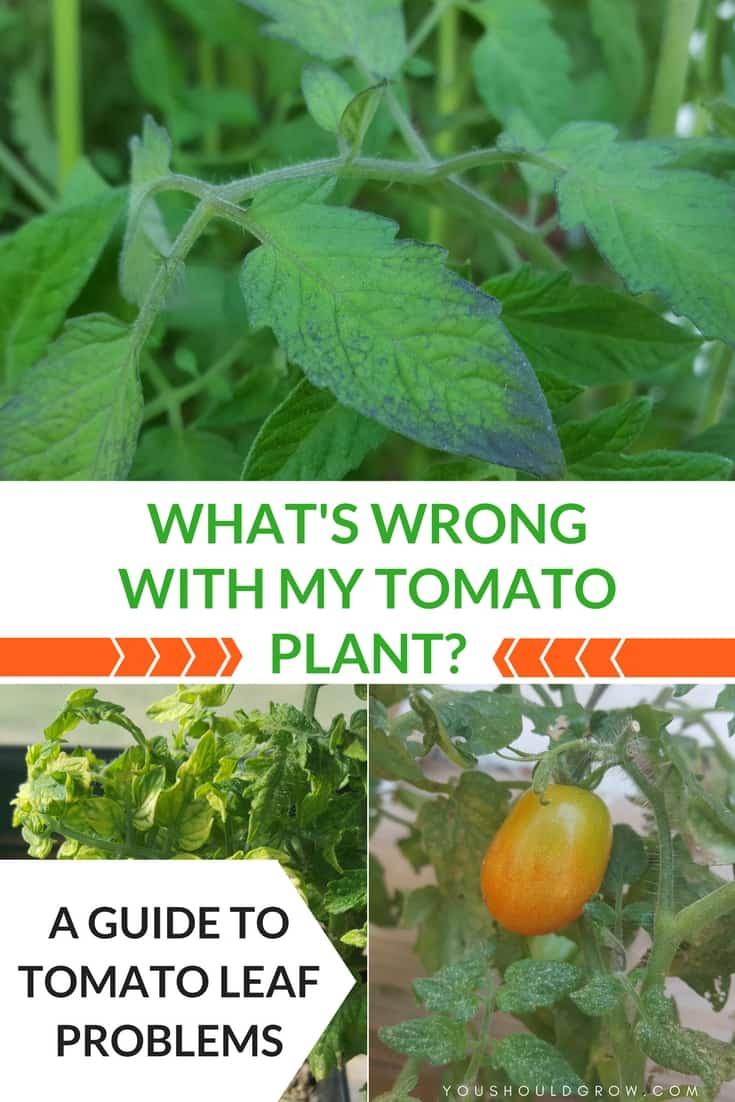
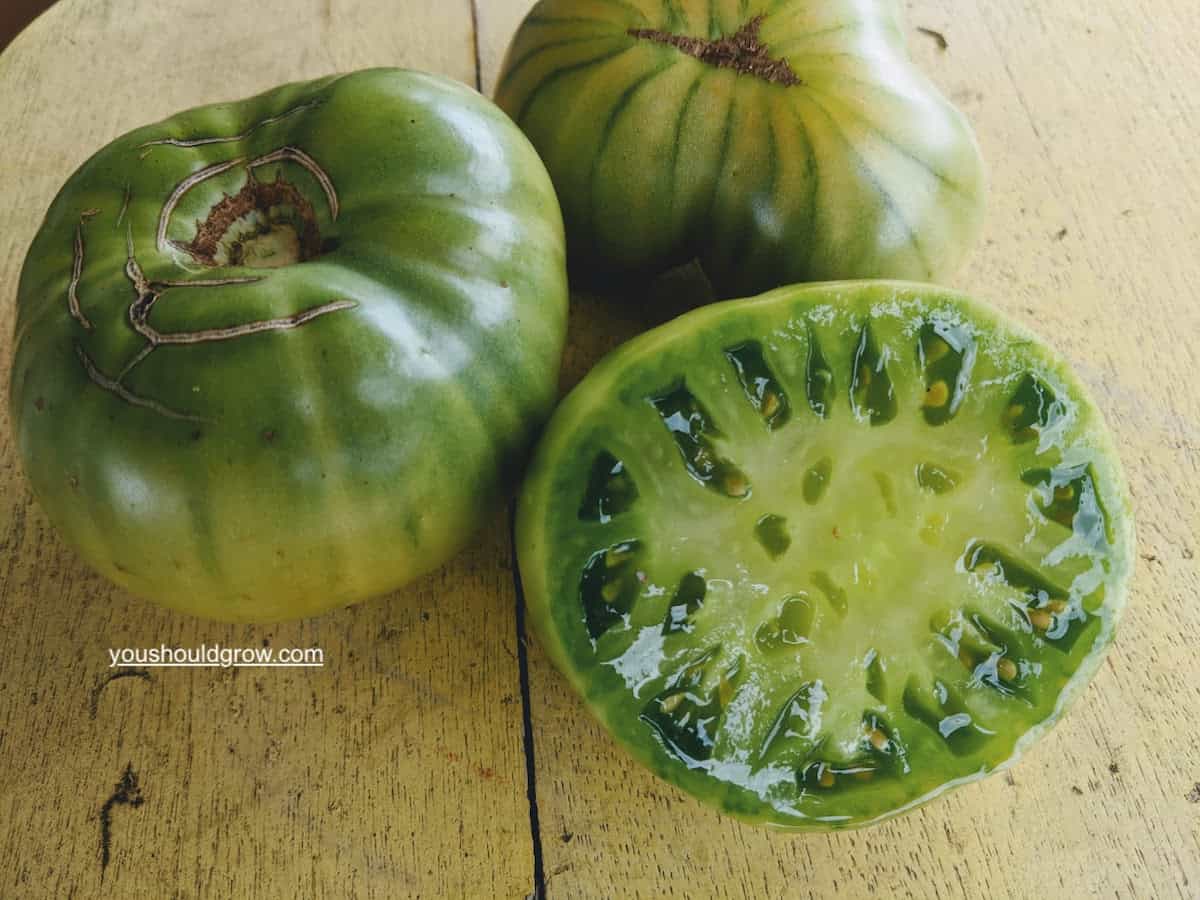
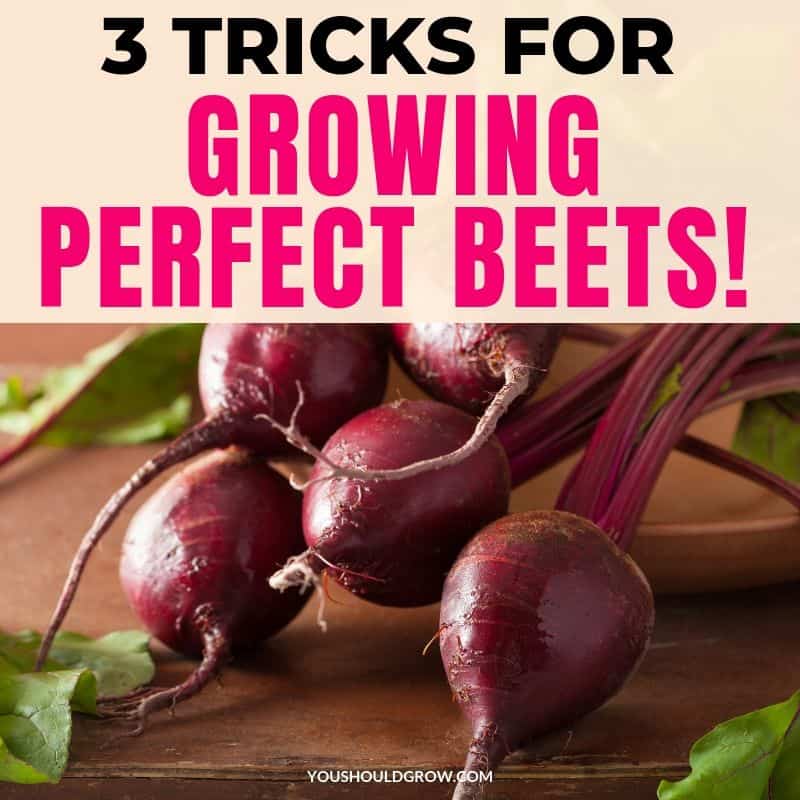
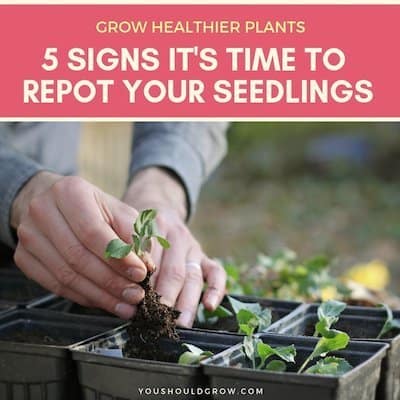
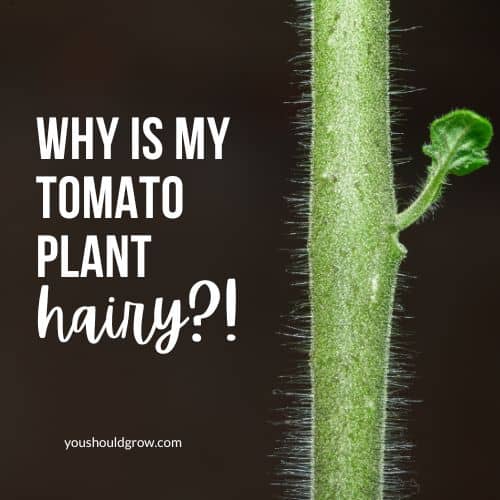
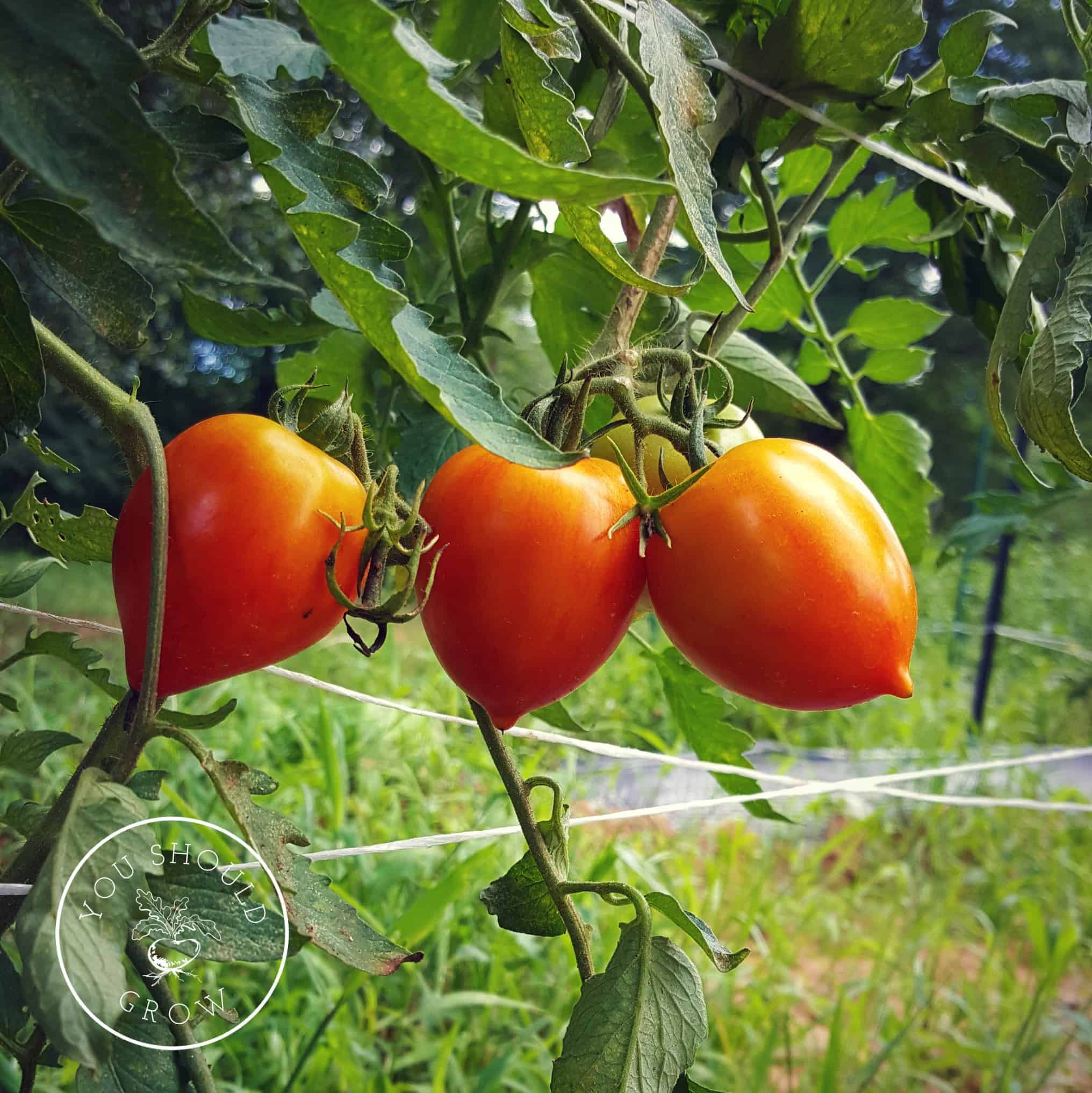
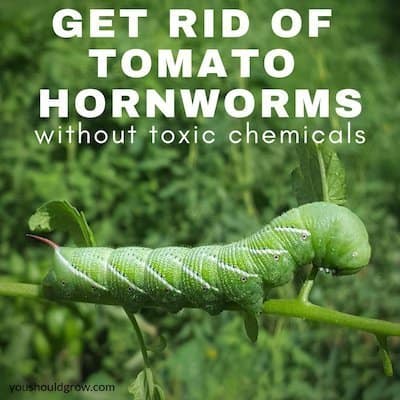
The newer leaves on my tomatoe plants are turning yellow from the stem to the leave. They are curling up from the outer sides of the leave. The leave are closer to the top of the plant. And it is not all the new leaves and not on all the plants. Can you help.
It’s hard to say based on that information, but my suggestions are to check for pests by looking under the leaves and on the stem. Address pest issues if seen and give it a dose of fish emulsion fertilizer. See if that helps. Good luck!
That was SO helpful! Thank you!
Hi, Raia! I’m very happy to hear that. 🙂 Thanks for visiting!
What a fantastic article! I live in zone 9b, so I have spider mites and fungal wilt (ugh). Tomatoes actually grow best fall-spring here! I’m waiting for my last plants to pitter out from spring and can’t grow again until late September.
This is a great comprehensive list! Thanks!
Hi Laura I liked your article. I just need to know if it is normal for my plants to wilt somewhat in the sun and perk right back up when the sun goes down. also they are planted in containers.
thanks Bob
Hey, Bob. Yes, that is completely normal on very hot, sunny days. 🙂
The leaves on my plant have brown spots and look wilted. Also there were a ton of flowers that never opened and upon looking today the flower shell is empty. Not one tomato is on this plant and the plant is about 3 feet tall and was planted around mothers day.
Hey, Hazel. I’m sorry to hear about your tomato plant. 🙁 Wilty leaves with brown spots could mean a bacterial or fungal infection. If the plant is otherwise healthy and producing, I usually trim those leaves and keep an eye on it. If the plant is brown and wilty all over and doesn’t have any fruit, you may consider removing it from your garden. Especially if you’ve seen similar symptoms on other plants. However, it’s worth noting that tomatoes will often not set fruit when the weather is very hot and humid. I hope this information helps. 🙂
I have sweet one hundred plants that look healthy but the small fruit are falling off. On each spray the first little tomatoes are gone but the still smaller ones toward the end of the spray are still there. Any suggestions would be appreciated. Thanks
Sometimes the tomato plant will not set a lot of fruit if the weather is very hot or humid. We have several plants that do not have a full spray of tomatoes. To increase fruit set, you can go out early in the morning before it gets hot and jiggle your plants. Also, cut back on pruning to increase flowering. Hope that helps. 🙂
Hi.. I’m growing in a greenhouse. I have treated with copper, Mycostop, Serenade, and am about to try Dr.Earths fungicide. Ibhace rust, and one I cant identify causing a black looking nloom on the plant and leaf death from the petiole out. Suggestions?
Hey, Denise. It sounds like you’ve done as much as you can. I’m not even sure Dr Earths will give you any additional benefit. I would only add that you should remove infected leaves and plants if you haven’t already. One thing to remember is that when the plants start to get sick, the best you can do is hope to prevent the spreading of the disease to other plants. Once disease shows up on a plant, there’s no going back. Keep your other plants healthy with good watering and fertilizing practices in addition to antifungals so they are more equipped to resist any disease pressures. Also, keep in mind that if the variety you planted has resistance to fungal disease, infected plants may still produce fruit. So don’t give up on them! I wish you luck!
I’ve just gotten a greenhouse and hope to raise some vegetables this winter, particularly tomatoes. I don’t know where to begin. Any suggestions on the type of tomato and the size of the pot, type of soil, etc.?
Jane Ann
Hi, Jane! I talk a lot about choosing tomatoes for containers in this post: https://wp.me/p7KuJw-1bH. I cover options for containers as well as fresh eating vs preserving. If you have more questions after reading that, please ask! A few tips specific to greenhouses: make sure you can keep the temperature inside the greenhouse between 65 and 80 during the day and warmer than 55 at night. These are your ideal temps for setting fruit. For soil, you can use any type of potting soil. Fox Farms Ocean Forrest is an excellent choice – well worth the cost. It should be easy to find at your local specialty garden centers. If you can’t find it there, try Amazon, but it’s about 2x as expensive 😱.
I am new to growing my own tomato plants this year, I’ve noticed a few leaves that had small white/yellow spots, maybe about 5 spots per leaf, any idea on what it could be?
Hi, Em! I’d like to see an image of the leaves in order to help you more. Please join my Facebook group (facebook.com/groups/youshouldgrow) so we can take a look!
Hi Laura,
Hopefully you still monitor this post from time to time (I’m late). I’m in zone 7B and we recently had a heat wave (mid/late May in NC). I’ve got about 6 plants spread between 4 raised beds (3’x2’ each) and on one of them the leaves have curled like a snail shell and seem to be growing that way now. New leaves are coming in curled up like that. They actually seem to be pretty strong healthy leaves, but I’m a little confused. I wondered if the heat had something to do with it, but it’s only on one plant. Even the plant that shares this raised bed is fine.
Is this normal leaf curling that I just haven’t encountered before?
Hi Mac! What you are describing could be a normal reaction to heat and humidity. Some varieties are more prone to curling than others. If the curling is also twisty/the leaves are deformed, then I would also consider whether there was any herbicide or pesticide treatment. You’re welcome to ask me questions anytime. My facebook group is also a good place to share questions and pictures: facebook.com/groups/youshouldgrow
This is incredibly handy to have. I haven’t run into too many problems outside of slight graying of leaves but this is a great go-to source. Thanks for posting!
You’re welcome, Karen! Thanks for visiting! 🙂
I have a raised garden and all of a sudden 3 of my tomato plants are wilting, we had about 5 inches of rain in the last week. My sister told me you cannot grow tomatoes by walnut trees, we have one about 30 feet from our raised beds, would this be killing my tomatoes?
Your sister is correct that walnut trees can be toxic for tomato plants, but they usually cause unusual and twisty growth patterns. Sudden wilting not due to excess heat and insufficient water is often caused by a soil-borne pathogen that causes them to wilt. If that’s the case, there’s nothing you can do and it may be the end of those plants. 🙁
What a wonderful article. I am an experienced gardener, and have been looking for a resource such as this with all potential leaf ailments in one spot. Thanks!
Lisa
Thanks, Lisa!! Glad it’s helpful for you! 🙂
HIgh, Interesting article!. I have been a vegetable gardner for many years in Belgium. Now for the first time I planted my square meter garden in the south of France (Riviera), about 30 km from the coast. As in many other parts of the world we are having a very hot summer with ungoing temperatures of over 30 degrees celsius (but there’s nothing wrong with the climat, is there Mr Trump!)
I started noticing yellowing of the leaves of the aubergines, very soon also on the tomato leaves. It looks like spider mites. I sprayed with home made garlic spray, but it does not seem to do the trick. Ons of the 2 aubergines looses al its flowers, the other one has a few fruits. The tomatoes have soms problems, like rotting on the bottoms especially on the SAn Marzano’s.
I thought of harvesting all the tomatoes and getting rid of the plants, but do you know any other way to avoid this?
Thanks or your advice and sorry for my bad English.!
Hi, Paula! If natural products like neem oil don’t work on the spider mites, you can try spinosad which is a naturally derived pesticide. It won’t kill bees as long as you don’t spray it directly on them. Once it dries, it only affects insects that eat the leaves.
The heat may have something to do with your tomatoes dropping flowers and developing blossom end rot. Paste tomatoes are especially prone to it, too. If the plants are looking okay, you might leave them and see if they’ll give you one more crop once the weather starts to cool. We keep ours under as 50% shade cloth because we always have summers topping 100F.
This year has been really rainy, though, so nothing is doing what it’s supposed to. LOL. Since I’ve been gardening, I’ve noticed that there’s no way to predict how the weather will go. Every year there is some sort of challenge. I guess that’s just nature’s way. 🙂 I wish you and your garden the best! Laura PS your English is fine! Way better than my French 🙂
I grow tomatoes is large pots.. Some of them are big, bushy, and producing lots of fruit. A couple of them, same type tomatoes, grown from seeds, same soil, same are of the yard, same care, are producing fruit, but all the foliage has turned brown and the leaves are all falling off. I examined them closely, I see no signs of bugs or anything. The fruit ripens, tastes good, a bit smaller than the others, but still good. Any idea what the problem is? I have moved those pots away from the others, ‘just in case’………help please? There is almost no foliage on these plants, and what little is still there doesn’t look like it will be for much longer.
Hi, Sharon! There are so many variables in tomato disease that it’s really hard to give you a definitive answer. If any of your containers are reused and/or didn’t get sanitized before planting, then it’s possible that they harbored disease like septoria. I think you did the right thing by moving them away from the others. You can also try spraying them down with neem oil or something like Serenade to see if that helps. If you really want to know, you can send a sample off with your county extension office and they’ll tell you exactly what it is. 🙂
So informative! I can tackle my tomato leaf problems with confidence now
“Organic” does so jack against aphids. I tried Neem oil, peppermint oil, and a few other things on my petunias that had aphids and the bugs just shrugged it off and kept sucking the plants dry. “Organic” is just a marketing ploy to get you to pay more money.
I think the key to using organic methods effectively is to accept that you’ll still have bugs after you apply them. There are organic versions of the most potent pesticides, but everything organic has to be applied and reapplied frequently.
No, they don’t work as well as non-organic methods. Part of why garden organically is because we don’t want to kill ALL the bugs. We understand and appreciate that bugs (good and bad) have a place in the garden.
I know this is not a timely response, but I post it here for others who may have the same problem. I sprayed my aphid infested tomatoes with a mixture of soap and water (1 TBS per quart) and in one application, got rid of 98% of the little pests. Make sure you spray the stems and undersides of the leaves as well as the top of the leaves, and do this in the early morning before the sun gets hot. A few days later, respray and thereafter repeat as necessary. Good luck!
My tomato plants have little holes in the leaves, I am talking MANY, some leaves are lost forever….I use miracle grow and seven dust spray and don’t seem to help if is a insect thing….Any help would be appreciated….I am without a clue..
Some diseases will also eat little holes in your plants. Sevin dust pretty much kills everything so, it could be an infection. Are other plants affected?
Hi. My tomato plants are only about 6 inches tall. They are turning purple and yellow and the leaves are curling upward. Very little green. We had a lot of rain last week, but things have dried out. What do you think might be wrong?
Hmm, have you seen thrips or any pests?
Very helpful article!
Thank you so much!..💚
hi new to this site I have 2 tomato plants out of 5 in one area and 5 out of 17 in a different area that started to look pale green all over and the leaves are curling inwards. The plant is not growing or dying. No brown or yellow spots on the leaves or stems just a pale not healthy looking. I have watered extra added fertilizer and sprayed with neem to no avail Any ideas?
Sounds like fertilizer issue, but the extra watering could be diluting what you added. Hold off on watering for a day or two and see how they do. Hit them with a good quality balanced fertilizer – where all the numbers (N-P-K) are the same.
My tomato plants were only marginally productive from May to the middle of August then all of a sudden there are dozens of fruits on them. They’er maturing nicely but not ripening. It has been cool at night, low 50’s, and mid to high 70’s during the days for about 10 days now. Is there anything I can do to hasten development or just be patient? I’m also finding some insanely huge caterpillars about twice a week that I take off and squish, would these have any effect on pants maturing other than they like to eat the tomatoes?.
Hi, Eric. You can encourage the plant to put more energy into ripening fruit if you cut off growing tips and flowers that haven’t set fruit. You can also cut back a little on watering and pick the fruit as soon as it blushes if frost is looming. We often pick our tomatoes when they start blushing so the caterpillars don’t get to them first. The caterpillars could also be a problem if they eat too many of the leaves off your plants. Hope you get some nice fruit!
Hi Laura, thank you for a very informative article. My tomato plants are growing and looking great other than some having new top growth leaves curling inwards. I understand that you say that unless there are other signs of disease, it should just be environmental, but is there any way to be sure? Thanks! If I could attach a photo, I would
You can always clip off a leaf and send it for testing with your county extension office.
Hello! Just got a new plant loaded with tomatoes. Just noticed black spots are appearing on the leaves, starting from the bottom but haven’t turned yellow; they just dry out. The stem also dries out with the “infected leaves”. I do not live in a humid environment but temperature ranges from 40 to 73 F.
What could it be?
Thanks so much!
It would be much easier if I could see a picture. Can you post it in the facebook group? Join here > facebook.com/groups/youshouldgrow
Too much fertilizer maybe? It could be affecting osmosis because of this, like salt sucking up the water from the plant
Hi, I wanted to let you know I found your article about guide for tomato leaf problems very helpful. Thank you, Richard
Hello,
My recently transplanted tomatoes have this strange look to them I’ve never seen: the lower leaves have what look like mud on them– a brown rusty color overspreading the leaves but apparently not penetrating them (the bottoms look normal except perhaps lighter than they should be. . I’m seeing it on different varieties. I didn’t plant where there were tomatoes last year. Any clues?
Adding to my last comment: it looks like mud, but it is not: the plants are mulched all around with grass clippings, and the brown does not wash off.
This is amazing info! I could use more images of the leaf issues but you nailed it! I am a self taught gardener in a super urban area and I try to do the best I can with the space I have and New England weather is always a challenge. These tips are great for people all over the USA. Keep up the good work and check me out on Instagram! I’d love to be able to share your tips with my followers and expand the knowledge so everyone can grow their own food! We may need these skills sooner than later…
@farmersaredope
What a great article, thanks. I’m still struggling to identify my issue and will likely remove the effected plant but am hoping thus isn’t bacterial canker or late blight that will spread to my other plants in hydroponic garden. My older leaves are curling, papery, grey. New growth seems fine. No algae growth, roots nice and white. I test my water and measure needed nutrients too. Because it is indoors, no bugs.
I have a photo I could post but could not figure out how. Thanks for any info. Kerri
Very informative! thank you for sharing!
Hi,
Great article. I have this page saved for the future.
I have 4 cherry tomato plants growing in containers which are about 45cm tall and fruiting. Just come home from work and noticed one of them, that the newer leaves have gone brown and dry from the tip to the middle of the leaves and some of the older leaves just have brown tips. Soils still moist from last watering with soluble fertiliser. Any ideas?
Thanks
You have SO many ads that on mobile the article jumps around constantly and half your photos won’t load due to ads constantly loading.
What is the point of writing a good detailed article such as this, if it’s so difficult to read that people give up entirely?
I have young tomatoe plants ( 8 – 13 in. ) that are showing leaves curling, healthy green color and the portion affected is very hairy. Some of the tops re also curling over. It looks like pesticide damage but there has been no pesticide sprayed here anywhere. Got any ideas what to do? I have about 300 plants for a garden plant sale.
I used grow bags with the self watering technique for my vegetables this year. Everything has exploded, especially my tomato plants. However, when the new leaves come in they are very fringed, jagged and withered looking until they grow out. It’s very creepy and weird- like the Little House Of Horrors plants. I’m wondering if the seeds were GMO or treated another way. Has anyone else noticed this problem? I purchased all kinds of tomato types and all grow out the same way. I’m a little leery of eating these tomatoes. Help!